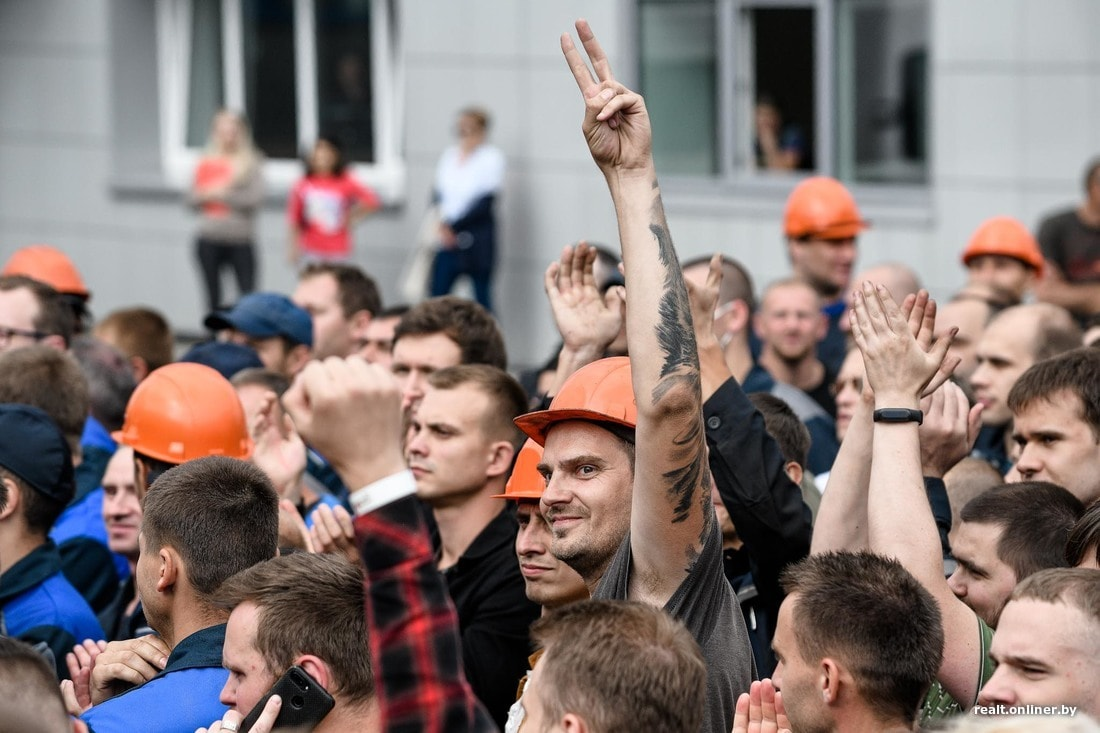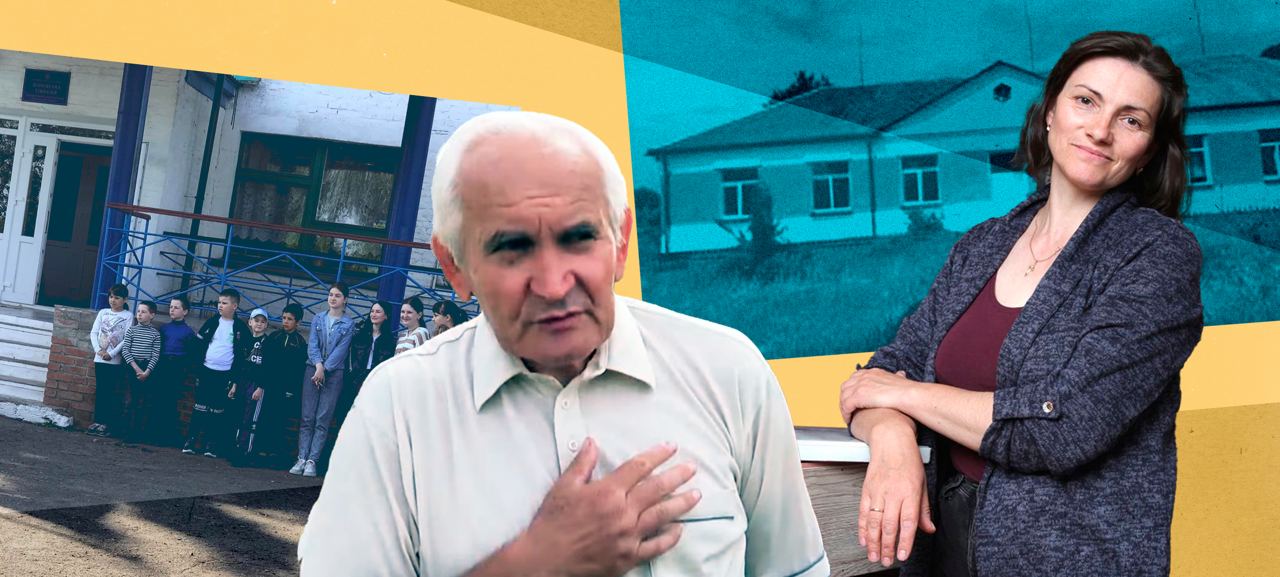These week’s protests in Belarus have clearly overcome their initial electoral focus and morphed into an expanding dissident movement of urban middle class and workers. In a recent (August 4) article for Open Democracy platform on the presidential campaign in Belarus, I tried to explain why the opposition candidates from the ruling elite and the “creative class” attracted a record number of supporters, which led to mass demonstrations unseen in this country for decades. I argued that these were the culmination of a protest sentiment simmering in Belarusian society since the economic crisis of 2009, that found expression in 2017 in the form of grassroots populist protests challenging Lukashenka’s degrading populist rhetoric. Before the most recent elections, his main opponent, Sviatlana Tsikhanouskaya, began to articulate an anti-authoritarian populist discourse that appealed to a cross-classalliance of entrepreneurs, young professionals, and workers. In this article I reflect on the questions I asked two weeks ago, about the role of the leadership and the masses in the current protests, the forms of their organization and the reaction of the Belarusian state. My reflections are based on a six-day marathon of digesting shreds of information coming through the fog of censorship, Internet disruptions and propaganda, as well as from communications with my comrades in Belarus. I am also building on my fieldwork experience among Belarusian workers and trade union activists in 2015-2017, which I conducted as a social anthropologist.
After a nervous election day on August 9, when observers reported numerous irregularities at polling stations, pro-government exit polls gave Lukashenka his traditional 80% of the vote, while his main rival Tsikhanovskaya was awarded almost 7%. This infuriated opposition supporters united under the slogan “I/We are the 97%”, with data drawn from their alternate count suggesting that Tsikhanouskaia got 45%. Both sides started preparing for a confrontation: the center of Minsk was cordoned off, Internet and mobile connections were disrupted, and paddy wagons and riot police appeared on the streets. Both Tsikhanovskaya and Lukashenka asked Belarusians to abide by the law and refrain from violence, although state TV channels accused the protesters of preparing provocations, while opposition Telegram channels called for resistance to the police.
On election night people took to the streets not for Tsikhanovskaya, but against Lukashenka. The opposition leader was not in sync with her supporters: she did not call for protests, emphasizing instead legal and bureaucratic means of contesting the official outcome of the elections. After having voted, people began gathering in Minsk and other cities, even prior to the announcement of the alternate vote count. The official numbers meant that nothing had supposedly changed since Lukashenka’s first election in 1994, but by this point it was clear to everyone that much had changed indeed.
Authorised mass gatherings are rare in Belarus, and on that night there definitely wasn’t going to be one. Thousands of people pouring from all corners of Minsk to the fortified city center were confronted with stun grenades, water cannons, and rubber bullets. Several uncoordinated groups attempted to build barricades. This was unprecedented repression for Minsk, accustomed instead to targeted arrests or rapid dispersal of compact crowds rather than to the flashes and explosions reminiscent of a military operation. Serious clashes also took place in many provincial cities and towns, some of which have not seen similar sights since WWII.
Illustrating the socially diverse nature of the pre-election mobilization, the post-election uprising took on a wide geographic scope from the beginning – with hundreds of people taking to the streets in all regional centers, as well as in many other settlements, often for the first time in a generation. Another early sign: the crowd, which looked impressively large, on the order of hundreds of thousands in Minsk and many thousands in regional centers, moved chaotically around the city, while riot police tried to force people out of public spaces. Police violence, the lack of central ideological and strategic leadership among the protesters, and the decentralized nature of the protests will determine their further development.
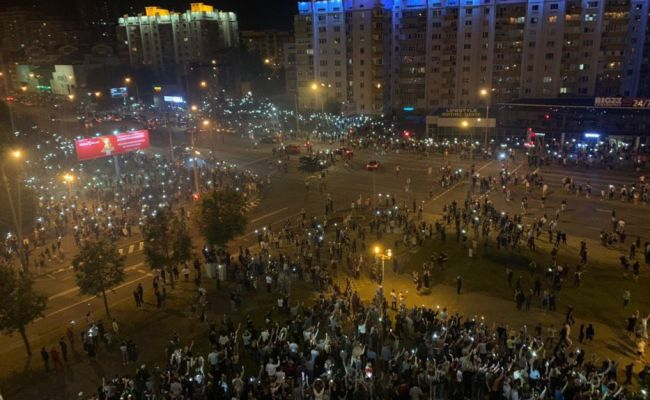
Minsk on the night of August 10 . Source: msvetov/Twitter
Postmodern partisans?
It seems that most of the protesters were participating in such events for the first time: analysts call the youth that hit the streets an ‘unbeaten generation.’ There were no visibly compact organized groups ready for serious tactical maneuvers, e.g. the seizure of administrative buildings, a ‘black bloc,’ disarming the police, the building of lasting barricades or tent camps, the use of improvised weapons, etc. This was in great contrast to previous electoral protests in Belarus in 2001, 2006 and 2010, which imitated the established pattern of ‘coloured revolutions’ in Serbia, Georgia and Ukraine. The state, in turn, demonstrated its ability to suppress the crowd by using Western-grade riot-control methods. Although Belarus is often referred to as a repressive state, the familiar ‘Parisian arsenal’ of tear gas canisters, water cannons, rubber bullets, and stun grenades was used here on a mass scale for the first time. Western technologies of violence were complemented by traditional post-Soviet police brutality: beating and detention of random people, torture, humiliation, and sometimes threats of rape in jail, the hunting down of journalists, etc.
The state did not try to rely on softer methods to prove its legitimacy. State media were instead silent about the discontent of the masses, scattered results in some constituencies indicating Lukashenka’s defeat were ignored, and ritual statements about foreign interference continued. Lukashenka’s rare screen appearances have sparked rumors of his departure to Turkey or of health problems. His reaction to the protests was advice for the participants to “find a job in an amicable way” so that they do not “walk the streets and avenues”: a relapse into his earlier discourses against“social parasitism,” which only added insult to injury for the protestors. The recourse towards police terror became obvious in the ensuing hours and days. After August 10, Minsk plunged into a de facto state of siege: public places were blocked, central metro stations were closed, Internet access was limited (Lukashenka claimed that someone from abroad was responsible for the shutdown), and some companies in the center of the city were closed in the evening. Even though the protesters refused to imitate the Ukrainian ‘Maidan’ with its civil-war-like intensity in the last days of February 2014, the Belarusian state wanted them to believe they were not in Minsk but in Kyiv – attempting to evoke through the thunder and lightning of police weapons the regime’s claims that all protests will inevitably lead to the Ukrainian disaster. Given the lack of substance in the state’s official ideology, violence became its only remaining ideology.

Demonstrative police brutality. Source: _tomato_hater/Twitter.
As a result of the security force’s demonstrative violence and the disorientation of the protesters, the mobilization on the streets began to decline, even though the popular wave of discontent was growing. The police quickly learned from the open Telegram channels about the protesters and their movements, but the protesters did not change their strategy (i.e. they did not develop any strategy). None of the opposition leaders joined the crowd or made radical statements. The opposition movement turned out to be on the whole amorphous, without clear leadership at the top and any leaders from below. At the same time, the ruling elite showed no signs of a split, the security apparatus and the bureaucracy generally remained loyal, although there have been signs of hesitation at the lower and regional levels (with several state media journalists and police officers resigning).
Throughout these five days the protest mobilizations on the streets of Belarusian cities have been as close as one gets to the decentralized, horizontal, leaderless networked resistance that postmodern anarchists envision. The opposition did not take part in the protests to begin with, while the Belarusian authorities escorted Tsikhanovskaya and her team coordinator to Lithuania
Since Tsikhanovskaya’s husband and some members of her team have been arrested, she is restrained from making any radical statements. In her last video she looked scared and depressed; she said that “no life is worth losing for what is happening now,” and hinted at threats to her children. Not a single opposition leader remained at large or in the country. Tsikhanovskaya’s husband’s Telegram channel, which fuelled the electoral mobilizations before, does not provide clear directions or coordination, and lags behind other anonymous social networks in reporting events.
There is no central coordination center of the protest, no local centers, no visible leaders on the street, no identifiable political groups. I believe that some already existing political groups are taking part in the protests, but they are not visible as separate ‘tactical units’: they are either disoriented, or deeply disguised, or participating as individuals.
This is partly out of necessity, since anyone suspected of leading the protests would be immediately detained and any in-person gathering would be quickly dispersed. It is impossible to imagine anything like “Occupy” or Gezi Park in Minsk these days, because the main public places are blocked and controlled by the police. The barricades are short-lived, and there is no question of seizing administrative buildings.
In part, however, this is a legacy of previous network mobilizations. Nearly two million subscribers, equal to the entire population of the capital, follow Nexta_live, a Telegram channel created two years ago by a Belarusian journalist from Poland. Despite its radical rhetoric, it relies on videos, photos and information provided by subscribers from various places across the country, but without much context. This is also the case for a dozen other protest channels that I’ve followed. The messages are often misleading, contradictory and unverified. It is reasonable to believe that some of these channels are being used by the special security services for instigating provocations and to obtain information about protesters’ plans.
Many have already compared these protests to the glorious Belarusian partisan tradition of the Second World War. This is, of course, an exaggeration, since the partisans actually had a chain of command and actual strategic and ideological leadership. They could pool resources and concentrate them in a relatively safe space, develop tactical plans and carry them out while waiting for a regular army. Nothing of the sort is happening within this postmodern uprising. Faced with the increasing presence of militia and army units that are using ostentatiously brutal methods, the protesters have carried out some sporadic aggressive actions with firecrackers, sticks, a few Molotov cocktails and the setting up of some rickety barricades. The response has been the same: detentions, beatings, injuries, and one confirmed death.
However, a decisive turn of events may come with the possible use of more traditional methods. As part of the protest campaign, a general strike was announced for August 11. The potential consequences are clear to anyone who knows about the April 1991 strikes in Belarus, the famous spectacle of a hundred thousand workers in front of the constructivist Government Building on Minsk’s Lenin Square. It was followed by a wave of strikes and mass demonstrations, which lasted a week and involved more than 80 enterprises in Minsk and throughout the country. This demoralized the Communist Party of Belarus and precipitated the collapse of the Soviet Union. But back in 1991 there were cells of anti-government workers’ organizations, which were joined by some official trade unions, as well as the example of successful miners’ strikes in Ukraine, Russia and Kazakhstan. The Communist Party was disoriented by the strife in Moscow, there was an opposition in parliament that claimed to represent workers, police were ordered not to intervene, and some enterprise directors supported their employees. Today the situation is clearly the opposite, so what can we expect?
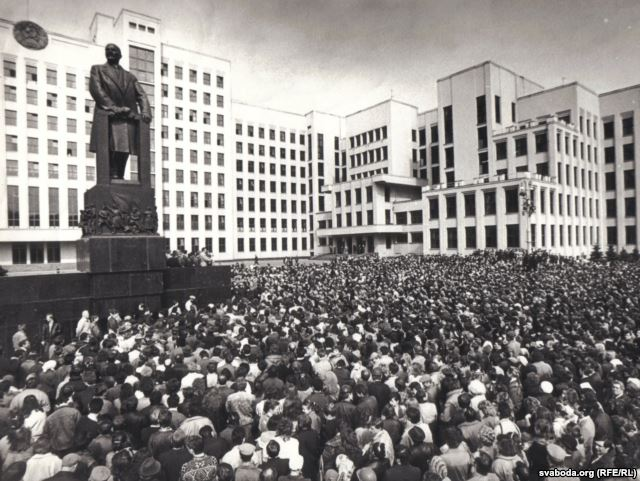
Minsk workers in Lenin Square on April 4, 1991. Source: Radio Free Europe/Radio Liberty
Which side are the workers on?
If you are skeptical about the working class, listen to the head of the Belarusian Mises Center: ”Protest activity will tend to zero until the proletariat joins.” As in the “good old” days, workers now have the most resources to gather peacefully in close quarters, without relying on the now precarious internet and without the fear of being arrested on the street. They are also the only class that can cause material damage to the state and challenge it ideologically. Belarusian industrial workers have an experience of cooperation and coordination, some kind of organizational structure, however bureaucratic, and a habit of formulating clear demands. My fieldwork among Belarusian workers and trade union activists in 2015-2017 taught me to be very careful not to overestimate the potential of organized labor in this country, but if there is a hope to resolve the impasse that the protest has entered in Belarus in a peaceful and progressive way, it can happen only thanks to an organized group of workers who understand, formulate and defend their interests.
There are already many scattered reports about unrest at some Belarusian state-owned industrial enterprises, including Minsk Automobile Plant, the world’s leading dump truck producer BelAZ and the chemical plant Grodno Azot, which are key to the country’s economy. This is, however, far from a general strike, and I would be cautious as to the prospects of this ever materializing. The Belarusian working class is atomized and individually dependent on the bosses at all levels. There have been no large-scale strikes since the 1990s, trade unions that are not coopted by the state are few in number (only about 9000 members) and lack resources. The spontaneous strikes that happened before were quickly suppressed.
A political strike is a great idea now, because the state still holds the commanding heights of the economy and employs 45% of the country’s workers. However, we are no longer in 1991, with its complex layering of conflicts within the ruling elite and with the relative autonomy of workers in factories. The current Belarusian labor regulation regime is worse for workers than during the late Soviet period, combining as it does the bureaucratic despotism of the Soviet past with the market despotism of the capitalist present.
However, I hope and suspect that some form of spontaneous organization is taking place at shopfloor level, as can be seen from the videos and reports of hundreds of workers gathering to put forward their demands to their superiors and insist on their implementation. These demands are: a recounting of the votes, guarantees that those who participated in street protests will not be fired, the release of detainees, the restoration of Internet access; they also amount to an expression of distrust in official trade unions.
These are ‘political’ demands brought from the streets, but more pressing economic demands can already be seen on the walls of the factories. A quote from a leaflet posted somewhere in a the Minsk Tractor Plant is illustrative:
The plant is still alive thanks to its workers!
No lathe knife? Go get it in Zhdanovichy [a village near Minsk, here:a place far away and difficult to get to]. Your boss didn’t give you working clothes? Fuck it, I’ll buy it on the market. Then the boss will ask you to stay after your shift finished because ‘you need to fulfill the plan.’ You get your paycheck and understand that you’ve been screwed. You complain to the trade union, but you already know the answer. You get an industrial injury and you register it as an off-the-job accident because ‘Well, you understand…’.
Fucking tired of all this, right?
The best way to influence the bosses is to go on strike. No need to go to the square and bang your helmet against the pavement. Just work to the rules […] Demand that each step of the technological process be performed according to the regulations. This is your right. As much as a decent wage and the fair elections are your rights that have been taken away from you.
Want to join but afraid of being fired? Remember, no scumbag ideologist will take your spot on the machine.
Lukashenka’s rule began with a bloody standoff with striking metro workers in 1995, who were ruthlessly dispersed, beaten, and fired. His rule tightened after he managed to split and subjugate the mammoth Federation of Trade Unions, whose chairman challenged him in the 2001 elections.
The ‘Belarusian model’ was built on fragmenting, disciplining, bribing and depriving the proletariat of its identity. In exchange for being deprived of their class subjectivity, workers were offered job preservation, restrictions on the commercialization of the social sphere, low utility bills and a ritual promise of $500 wages. Borrowing a Gramscian phrase, I call this a Belarusian ‘passive revolution’: an authoritarian path of post-socialist transformation, spurred and mediated by the fear of spontaneous protests emerging from antagonistic social classes. Perhaps workers can change the direction of this process by regaining their subjectivity. It definitely won’t happen overnight or this week, but I can’t think of another optimistic utopia to resolve the current impasse.
My conviction that organized labor, and not a decentralized network movement without leaders, is the only agent capable of formulating clear requirements and making the authorities listen, can be illustrated by a video of the meeting between workers of the BelAZ plant and the mayor of Zhodino, which took place on August 13. At lunchtime, several hundred workers gathered outside the factory gates and met with their director and later with the mayor. The conversation was tense but respectful. The mayor looked confused and timid. The workers demanded that their colleagues, relatives, and friends be released from the pre-trial detention center, that the special forces be sent out of the city (“Why do we need a salary if we are beaten?”), and their votes recounted. They insisted that their city was safe, and they were in control of the situation. The mayor, of course, could not make any clear promises, but agreed to meet with the workers outside the plant in the evening to discuss their demands. He was seen off with the words “Thank you!” and chants of “The Mayor with the people!” The plant hasn’t stopped working, but after watching the video, I’m less skeptical about the possibility of a real protracted strike. So far, this is the only channel through which the protesters can force the authorities into a kind of dialogue at the local level. If the central government cuts this opportunity, that will only be to its own detriment.
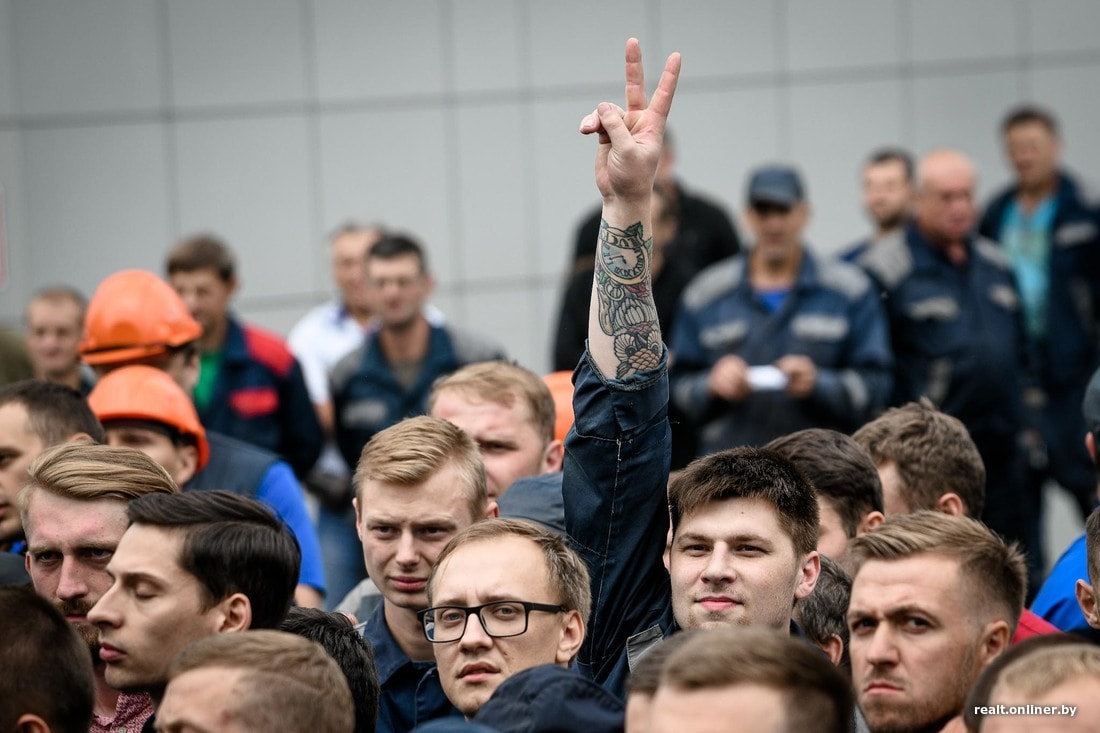
BelAZ workers on August 13.
Later that day the mayor eventually met with a huge crowd of BelAZ workers and other townspeople. Instead of exploding stun grenades and the sounds of rubber bullets, a long and not very fruitful conversation took place about the falsification of elections, the violence of the riot police, and the need to release those detained in the local pre-trial detention center, many of whom were brought from Minsk.
After uttering a variation on his favorite theme of “undress and work,” Lukashenka also “heard the opinion of labor collectives” and promised to “deal with” the police outrage, and the chief of police apologized for the excesses. The authorities began to back down, but the people were not completely satisfied and the situation continues to develop.
As I finish this article, on August 14, the Minsk Tractor Plant has risen up. Workers were very hesitant and anxious the day before, they could not decide when and how to gather and what to do. But thousands of them nevertheless gathered in front of their factory gates and marched towards the city center, joined by various other demonstrators, the ‘postmodern partisans’ mentioned above. This was a calm day, the riot police stood on guard but did not disperse the crowd. The route was the same as in 1991: from the industrial Partizan district of Minsk to Independence Square, formerly known as Lenin Square…
This is an updated and revised version of the article that first appeared in Russian in Commons, and first published in English in the Lefteast
